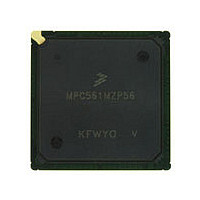MPC561MZP56 Freescale, MPC561MZP56 Datasheet - Page 1220

MPC561MZP56
Manufacturer Part Number
MPC561MZP56
Description
Manufacturer
Freescale
Datasheet
1.MPC561MZP56.pdf
(1420 pages)
Specifications of MPC561MZP56
Cpu Family
MPC56x
Device Core
PowerPC
Device Core Size
32b
Frequency (max)
56MHz
Interface Type
QSPI/SCI/SPI/UART
Total Internal Ram Size
32KB
# I/os (max)
56
Number Of Timers - General Purpose
22
Operating Supply Voltage (typ)
2.6/5V
Operating Supply Voltage (max)
2.7/5.25V
Operating Supply Voltage (min)
2.5/4.75V
On-chip Adc
2(32-chx10-bit)
Instruction Set Architecture
RISC
Operating Temp Range
-40C to 125C
Operating Temperature Classification
Automotive
Mounting
Surface Mount
Pin Count
388
Package Type
BGA
Program Memory Type
ROMLess
Program Memory Size
Not Required
Lead Free Status / RoHS Status
Not Compliant
Available stocks
Company
Part Number
Manufacturer
Quantity
Price
Company:
Part Number:
MPC561MZP56
Manufacturer:
Freescale Semiconductor
Quantity:
10 000
Company:
Part Number:
MPC561MZP56R2
Manufacturer:
Freescale Semiconductor
Quantity:
10 000
- Current page: 1220 of 1420
- Download datasheet (11Mb)
Electrical Characteristics
An estimation of the chip junction temperature, T
where:
The junction to ambient thermal resistance is an industry standard value which provides a quick and easy
estimation of thermal performance. Unfortunately, the answer is only an estimate; test cases have
demonstrated that errors of a factor of two are possible. As a result, more detailed thermal characterization
is supplied.
Historically, the thermal resistance has frequently been expressed as the sum of a junction to case thermal
resistance and a case to ambient thermal resistance:
where:
R
case to ambient thermal resistance, R
a heat sink, change the mounting arrangement on printed circuit board, or change the thermal dissipation
on the printed circuit board surrounding the device. This description is most useful for ceramic packages
with heat sinks where about 90% of the heat flow is through the case to the heat sink to ambient. For most
packages, a better model is required.
The simplest thermal model of a package which has demonstrated reasonable accuracy (about 20 percent)
is a two resistor model consisting of a junction to board and a junction to case thermal resistance. The
junction to case covers the situation where a heat sink will be used or where a substantial amount of heat
is dissipated from the top of the package. The junction to board thermal resistance describes the thermal
performance when most of the heat is conducted to the printed circuit board. It has been observed that the
thermal performance of most plastic packages and especially PBGA packages is strongly dependent on the
board. temperature.
If the board temperature is known, an estimate of the junction temperature in the environment can be made
using the following equation:
where:
F-4
θJC
is device related and cannot be influenced. The user controls the thermal environment to change the
T
T
R
P
R
R
R
R
T
T
R
P
A
D
D
J
J
B
θJA
θJA
θJA
θJC
θJA
θJB
= T
= T
= ambient temperature (°C)
= power dissipation in package
= board temperature (°C)
= power dissipation in package (
= junction to case thermal resistance (°C/W)
= package junction to board resistance (°C/W)
= package junction to ambient resistance (°C/W)
= R
= junction to ambient thermal resistance (°C/W)
= case to ambient thermal resistance (°C/W)
A
B
+ (R
+ (R
θJC
θJA
+ R
θJB
θCA
x P
x P
D
D
)
)
MPC561/MPC563 Reference Manual, Rev. 1.2
θCA
. For instance, the air flow can be changed around the device, add
Ω
)
J
, in °C can be obtained from the equation:
Freescale Semiconductor
Related parts for MPC561MZP56
Image
Part Number
Description
Manufacturer
Datasheet
Request
R

Part Number:
Description:
MPC5 1K0 5%
Manufacturer:
TE Connectivity
Datasheet:

Part Number:
Description:
MPC5 500R 5%
Manufacturer:
TE Connectivity
Datasheet:

Part Number:
Description:
MPC5 5K0 5%
Manufacturer:
Tyco Electronics
Datasheet:

Part Number:
Description:
MPC5 5R0 5%
Manufacturer:
Tyco Electronics
Datasheet:

Part Number:
Description:
MPC5 50K 5%
Manufacturer:
Tyco Electronics
Datasheet:

Part Number:
Description:
MPC5 1R0 5%
Manufacturer:
Tyco Electronics
Datasheet:

Part Number:
Description:
TOWER ELEVATOR BOARDS HARDWARE
Manufacturer:
Freescale Semiconductor
Datasheet:

Part Number:
Description:
TOWER SERIAL I/O HARDWARE
Manufacturer:
Freescale Semiconductor
Datasheet:

Part Number:
Description:
LCD MODULE FOR TWR SYSTEM
Manufacturer:
Freescale Semiconductor
Datasheet:

Part Number:
Description:
DAUGHTER LCD WVGA I.MX51
Manufacturer:
Freescale Semiconductor
Datasheet:

Part Number:
Description:
TOWER SYSTEM BOARD MPC5125
Manufacturer:
Freescale Semiconductor
Datasheet:












